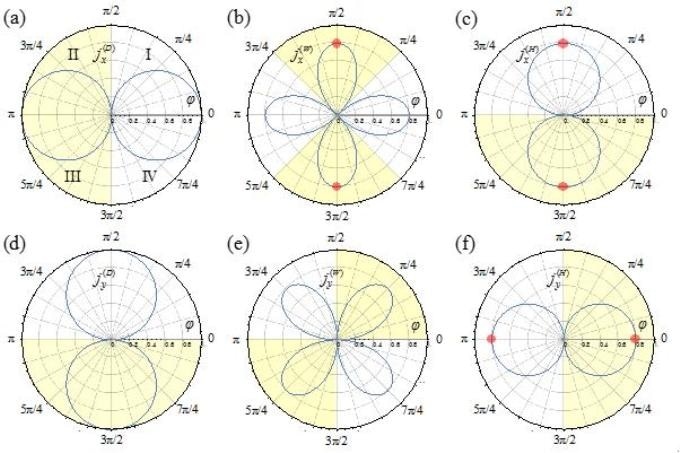Jul 24 2019
Scientists at the Center for Theoretical Physics of Complex Systems (PCS), within the Institute for Basic Science (IBS, South Korea), and teammates have described a new phenomenon, known as Valley Acoustoelectric Effect, which occurs in 2D materials, like graphene.
 Angular patterns of the x- and y- components of the conventional (a, d), warping (b, e) and Hall (c, f) electric current density. Yellow shading marks the areas of negative current (directed opposite to x- or y-axis). Red dots manifest the special angles, at which only the unconventional current flows along the x- or y-direction. (Image credit: IBS)
Angular patterns of the x- and y- components of the conventional (a, d), warping (b, e) and Hall (c, f) electric current density. Yellow shading marks the areas of negative current (directed opposite to x- or y-axis). Red dots manifest the special angles, at which only the unconventional current flows along the x- or y-direction. (Image credit: IBS)
This study has been reported in Physical Review Letters and offers new understanding of the research on valleytronics.
Acoustoelectronics involves the use of surface acoustic waves (SAWs) to produce electric currents. In this research, the group of theoretical physicists modeled the propagation of SAWs in emerging 2D materials, like single-layer molybdenum disulfide (MoS2). SAWs attract MoS2 electrons (and holes), generating an electric current with conventional and unconventional components.
The latter includes two contributions: a Hall current and a warping-based current. The first is direction-dependent, is associated with what are called valleys—local energy minima of electrons—and is similar to one of the mechanisms describing the photovoltaic effects of 2D materials exposed to light.
The second is because of a particular effect (Berry phase) that influences the velocity of these electrons moving as a group and leads to fascinating phenomena, for example, anomalous and quantum Hall effects.
The research group examined the properties of the acoustoelectric current, proposing a method to operate and measure the conventional, warping, and Hall currents independently. This enables both optical and acoustic methods to be used simultaneously to control the propagation of charge carriers in new 2D materials, developing new logical devices.
The scientists are looking forward to controlling the physical properties of these ultra-thin systems, specifically, those electrons that can freely move in two dimensions, but strongly restricted in the third.
It will be possible to investigate technologies further than silicon electronics by limiting the parameters of the electrons, specifically, their spin, momentum, and valley. For example, MoS2 has two district valleys, which could possibly be employed in the future for bit storage and processing, making it a suitable material to explore valleytronics.
Our theory opens a way to manipulate valley transport by acoustic methods, expanding the applicability of valleytronic effects on acoustoelectronic devices.
Ivan Savenko, Leader, Light-Matter Interaction in Nanostructures Team, Center for Theoretical Physics of Complex Systems, Institute for Basic Science